
Mino Thirty-three Kannon
Encyclopedia
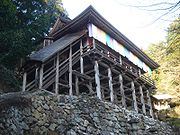
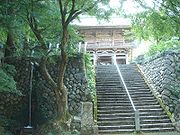
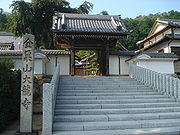
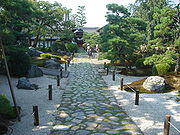
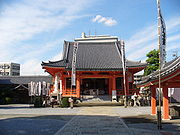
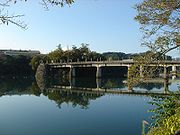
Gifu Prefecture
is a prefecture located in the Chūbu region of central Japan. Its capital is the city of Gifu.Located in the center of Japan, it has long played an important part as the crossroads of Japan, connecting the east to the west through such routes as the Nakasendō...
, Japan
Japan
Japan is an island nation in East Asia. Located in the Pacific Ocean, it lies to the east of the Sea of Japan, China, North Korea, South Korea and Russia, stretching from the Sea of Okhotsk in the north to the East China Sea and Taiwan in the south...
. The name is derived from Mino Province
Mino Province
, one of the old provinces of Japan, encompassed part of modern-day Gifu Prefecture. It was sometimes called . Mino Province bordered Echizen, Hida, Ise, Mikawa, Ōmi, Owari, and Shinano Provinces....
, the former name for the area. The list was originally created during the mid-Edo period
Edo period
The , or , is a division of Japanese history which was ruled by the shoguns of the Tokugawa family, running from 1603 to 1868. The political entity of this period was the Tokugawa shogunate....
.
Thirty-three Kannon
| No. | Name | Japanese | Sangō | Sect | Location |
|---|---|---|---|---|---|
| 1 | Nichiryūbu-ji | 日龍峰寺 | Dainichi-san | Shingon Shingon Buddhism is one of the mainstream major schools of Japanese Buddhism and one of the few surviving Esoteric Buddhist lineages that started in the 3rd to 4th century CE that originally spread from India to China through traveling monks such as Vajrabodhi and Amoghavajra... |
Seki Seki, Gifu is a city located in Gifu, Japan.The city was founded on October 15, 1950.On February 7, 2005, the municipalities of Horado, Itadori, Kaminoho, Mugegawa and Mugi, all part of Mugi District, were merged into the present-day city... |
| 2 | Rokuon-ji | 鹿苑寺 | Kongō-san | Rinzai Rinzai school The Rinzai school is , one of three sects of Zen in Japanese Buddhism.Rinzai is the Japanese line of the Chinese Linji school, which was founded during the Tang Dynasty by Linji Yixuan... |
Mino Mino, Gifu is a city located in the Gifu Prefecture of central Japan.Founded on 1 April 1954, Mino covers a total area of 117.05 km². As of July 2011 the city had an estimated population of 22,447 inhabitants.... |
| 3 | Raishō-ji | 来昌寺 | Chōei-zan | Pure Land Pure Land Buddhism Pure Land Buddhism , also referred to as Amidism in English, is a broad branch of Mahāyāna Buddhism and currently one of the most popular traditions of Buddhism in East Asia. Pure Land is a branch of Buddhism focused on Amitābha Buddha... |
Mino |
| 4 | Hōshō-in | 宝勝院 | Konpira-san | Shingon | Mino |
| 5 | Eishō-ji | 永昌寺 | Kaiun-zan | Rinzai | Seki |
| 6 | Eri-ji | 恵利寺 | Ozaki-yama | Rinzai | Seki |
| 7 | Ryōfuku-ji | 龍福寺 | Iwaya-san | Rinzai | Seki |
| 8 | Sankō-ji | 三光寺 | Ryūō-san | Shingon | Yamagata Yamagata, Gifu is a city located in Gifu, Japan.-History:The city was established on April 1, 2003, by merger of the towns of Miyama and Takatomi, and the village of Ijira, all from Yamagata District.-External links:*... |
| 9 | Tōkō-ji | 東光寺 | Fuji-san | Rinzai | Yamagata |
| 10 | Kōgon-ji | 広厳寺 | Hōun-zan | Rinzai | Yamagata |
| 11 | Dairyū-ji Dairyu-ji (Gifu) is a Buddhist temple of the Rinzai school located in Gifu, Gifu Prefecture, Japan. It is one of the Mino Thirty-three Kannon. It is located near the Takatomi-chō area of Yamagata, so it is also sometimes referred to as Takatomi Dairyū-ji... |
大龍寺 | Kinzoku-san | Rinzai | Gifu Gifu, Gifu is a city located in the south-central portion of Gifu Prefecture, Japan, and serves as the prefectural capital. The city has played an important role in Japan's history because of its location in the middle of the country. During the Sengoku period, various warlords, including Oda Nobunaga, used... |
| 12 | Taikō-in | 退耕院 | Myōchi-zan | Rinzai | Minokamo Minokamo, Gifu is a city located in Gifu Prefecture, Japan, and was formed on April 1, 1954.As of July 2011, the city has an estimated population of 54,944. The total area is 74.81 km².-Rail:*JR Central:**Takayama Main Line: Mino-Ōta Station, Kobi Station... |
| 13 | Kannami-ji | 甘南美寺 | Hakuka-san | Rinzai | Yamagata |
| 14 | Sōfuku-ji Sofuku-ji (Gifu) ' is a Buddhist temple located in Gifu, Gifu Prefecture, Japan. The temple has strong ties to both Saitō Dōsan and Oda Nobunaga. Gifu's Sōfuku-ji is famed throughout Japan for both the number of monks it produces and for its "Blood Ceiling". Shortly after its founding, it was also known as Kōsai-ji... |
崇福寺 | Shingo-zan | Rinzai | Gifu |
| 15 | Hokke-ji Hokke-ji (Gifu) is a Buddhist temple of the Shingon school located in Gifu, Gifu Prefecture, Japan. Though its formal name is Hokke-ji, it is more well known by its unofficial name, Mitahora Kōbō .... |
法華寺 | Ryōju-san | Shingon | Gifu |
| 16 | Ganjō-ji | 願成寺 | Nyoi-zan | Shingon | Gifu |
| 17 | Gokokushi-ji Gokokushi-ji is a Buddhist temple of the Shingon sect located in Gifu, Gifu Prefecture, Japan. It is the seventeenth of the Mino Thirty-three Kannon.-History:... |
護国之寺 | Yūsō-san | Shingon | Gifu |
| 18 | Mie-ji Mie-ji is a Buddhist temple of the Tendai sect located in Gifu, Gifu Prefecture, Japan. It is also referred to as Mie-ji Kannon . It is one of the Mino Thirty-three Kannon... |
美江寺 | Dainichi-san | Tendai Tendai is a Japanese school of Mahayana Buddhism, a descendant of the Chinese Tiantai or Lotus Sutra school.Chappell frames the relevance of Tendai for a universal Buddhism:- History :... |
Gifu |
| 19 | Enkyō-ji | 円鏡寺 | Chikyō-zan | Shingon | Kitagata Kitagata, Gifu is a town located in Motosu District, Gifu, Japan.As of 2011, the town has an estimated population of 18,389. The total area is 5.17 km². The town is completely surrounded by the three cities of Gifu, Motosu and Mizuho.-External links:*... |
| 20 | Guzei-ji | 弘誓寺 | Shigu-san | Rinzai | Yamagata |
| 21 | Hōshaku-ji | 宝積寺 | Rinzai | Sakahogi Sakahogi, Gifu is a town located in Kamo District, Gifu, Japan.As of July 2011, the town has an estimated population of 8,443. The total area is 12.89 km². The town was formed in 1968.-History:Sakahogi was formed on October 1, 1968 when the village of gained town status... |
|
| 22 | Manshaku-ji | 万尺寺 | Rinzai | Minokamo | |
| 23 | Kichijō-ji | 吉祥寺 | Shingū-yama | Rinzai | Seki |
| 24 | Jinkō-ji | 神光寺 | Shingon | Seki | |
| 25 | Sōkei-ji | 曹渓寺 | Rinzai | Mino | |
| 26 | Kiyomizu-dera | 清水寺 | Hakka-zan | Rinzai | Tomika Tomika, Gifu is a town located in Kamo District, Gifu Prefecture, Japan.-History:Tomika was originally established as a village in 1954, when the villages of Tomida and Kajita merged. It received town status in 1974... |
| 27 | Yūsen-ji | 祐泉寺 | Iō-zen | Rinzai | Minokamo |
| 28 | Ryōfuku-ji | 龍福寺 | Rinza-san | Rinzai | Tomika |
| 29 | Shōzan-ji | 小山寺 | Rinzai | Minokamo | |
| 30 | Zenpuku-ji | 善福寺 | Jōdo Shinshū Jodo Shinshu , also known as Shin Buddhism, is a school of Pure Land Buddhism. It was founded by the former Tendai Japanese monk Shinran. Today, Shin Buddhism is considered the most widely practiced branch of Buddhism in Japan.-Shinran :... |
Gifu | |
| 31 | Tokuun-ji | 徳雲寺 | Sōtō Soto Sōtō Zen , or is, with Rinzai and Ōbaku, one of the three most populous sects of Zen in Japanese Buddhism.The Sōtō sect was first established as the Caodong sect during the Tang Dynasty in China by Dongshan Liangjie in the 9th century, which Dōgen Zenji then brought to Japan in the 13th century... |
Minokamo | |
| 32 | Ryūzō-ji | 立蔵寺 | Sōtō | Seki | |
| 33 | Shinchōkoku-ji | 新長谷寺 | Yoshida-yama | Shingon | Seki |
Tōkai Hundred Kannon
The Mino Thirty-three Kannon combine with the Owari Thirty-three KannonOwari Thirty-three Kannon
The are a collection of Buddhist temples in western Aichi Prefecture, Japan, all dedicated to the bodhisattva Avalokitesvara. The name is derived from Owari Province, the former name for the area...
in western Aichi Prefecture
Aichi Prefecture
is a prefecture of Japan located in the Chūbu region. The region of Aichi is also known as the Tōkai region. The capital is Nagoya. It is the focus of the Chūkyō Metropolitan Area.- History :...
, the Mikawa Thirty-three Kannon
Mikawa Thirty-three Kannon
The are a collection of Buddhist temples in eastern Aichi Prefecture, Japan, most of which are near Mikawa Bay. The name is derived from Mikawa Province, the former name for the area.-Thirty-three Kannon:-Tōkai Hundred Kannon:...
in eastern Aichi Prefecture and Toyokawa Inari
Toyokawa Inari
is the popular name for a Buddhist temple of the Sōtō sect located in the city of Toyokawa in eastern Aichi Prefecture, Japan. The temple’s true name is , or full name is...
to form the Tōkai Hundred Kannon
Tōkai Hundred Kannon
The are a collection of one-hundred Buddhist temples in the Tōkai region of central Honshū, Japan.The Tōkai Hundred Kannon is made of up of the Mino Thirty-three Kannon in Gifu Prefecture, the Owari Thirty-three Kannon in western Aichi Prefecture, the Mikawa Thirty-three Kannon in eastern Aichi...
.
See also
- Tōkai Hundred KannonTōkai Hundred KannonThe are a collection of one-hundred Buddhist temples in the Tōkai region of central Honshū, Japan.The Tōkai Hundred Kannon is made of up of the Mino Thirty-three Kannon in Gifu Prefecture, the Owari Thirty-three Kannon in western Aichi Prefecture, the Mikawa Thirty-three Kannon in eastern Aichi...
- Owari Thirty-three KannonOwari Thirty-three KannonThe are a collection of Buddhist temples in western Aichi Prefecture, Japan, all dedicated to the bodhisattva Avalokitesvara. The name is derived from Owari Province, the former name for the area...
- Toyokawa InariToyokawa Inariis the popular name for a Buddhist temple of the Sōtō sect located in the city of Toyokawa in eastern Aichi Prefecture, Japan. The temple’s true name is , or full name is...
- Owari Thirty-three Kannon
- Glossary of Japanese BuddhismGlossary of Japanese BuddhismThis is the glossary of Japanese Buddhism, including major terms the casual reader might find useful in understanding articles on the subject. Words followed by an asterisk are illustrated by an image in one of the photo galleries...
, for an explanation of terms concerning Japanese Buddhism

